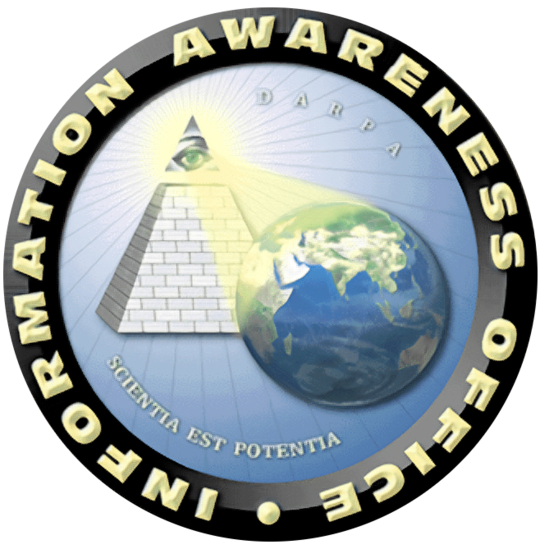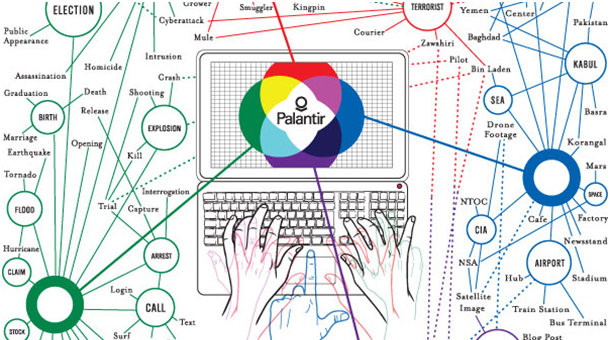Imagine a company that knows everything about everyone. A company that is equally at ease helping banks identify fraud as it is helping intelligence agencies track down enemies of the state. A company that can combine pictures of you with your cell phone location data, emails you’ve written, your health records and credit card purchases and thousands of other pieces of electronic data to paint an intimate portrait of your life—a portrait that any would-be investigator can pull up with a few keystrokes. A company that can target you anywhere in the world at any time.
Now stop imagining that company, because it already exists. It’s called Palantir Technologies.
Founded by billionaire PayPal co-founder and Facebook early investor Peter Thiel, this plucky little Silicon Valley startup has long been the darling of the US military and the intelligence community, and it’s increasingly the darling of the corporate world. And—given Palantir’s ability to surveil, track and, ultimately, control every aspect of your daily life—it isn’t hard to see why.
Even so, few in the general public have ever heard of it, and those who have know little beyond the fact that Palantir is a bad company that does creepy things.
But this is The Corbett Report. We can do better than that.
Today, let’s explore the roots of this threat to humanity, expose the extent to which it has already laid your life bare to the all-seeing eye of the would-be world controllers, and peer into the magical seeing stone to see what the future holds for Palantir Technologies.
To access this week’s edition of The Corbett Report Subscriber, please sign in and continue reading below.
Not a Corbett Report member yet? Sign up to BECOME A MEMBER of the website and read the full newsletter or CLICK HERE to access the editorial for free.
|
The Corbett Report Subscriber
|
vol 12 issue 29 (October 23, 2022)
|

by James Corbett Imagine a company that knows everything about everyone. A company that is equally at ease helping banks identify fraud as it is helping intelligence agencies track down enemies of the state. A company that can combine pictures of you with your cell phone location data, emails you’ve written, your health records and credit card purchases and thousands of other pieces of electronic data to paint an intimate portrait of your life—a portrait that any would-be investigator can pull up with a few keystrokes. A company that can target you anywhere in the world at any time. Now stop imagining that company, because it already exists. It’s called Palantir Technologies. Founded by billionaire PayPal co-founder and Facebook early investor Peter Thiel, this plucky little Silicon Valley startup has long been the darling of the US military and the intelligence community, and it’s increasingly the darling of the corporate world. And—given Palantir’s ability to surveil, track and, ultimately, control every aspect of your daily life—it isn’t hard to see why. Even so, few in the general public have ever heard of Palantir, and those who have know little beyond the fact that it’s a bad company that does creepy things. But this is The Corbett Report. We can do better than that. Today, let’s explore the roots of this threat to humanity, expose the extent to which it has already laid your life bare to the all-seeing eye of the would-be world controllers, and peer into the magical seeing stone to see what the future holds for Palantir Technologies. WHAT IS PALANTIR? So, what is Palantir, exactly? As it turns out, that question is surprisingly easy to answer. Palantir is a front company for a once-secret military and intelligence project to collect and data mine every available piece of information about you. The hard part is extracting that simple answer from the mass of lies, obfuscation, untruths, half-truths and contextless facts that are presented in the lamestream media’s coverage of the company. You see, the official story of this Silicon Valley surveillance specialist outfit—repeated in any number of mainstream puff pieces—is that Peter Thiel founded Palantir Technologies in 2004 as a vehicle for turning PayPal’s fraud detection software into a marketable product. His dream was for Palantir to assist the growing national security leviathan in creating a system for analyzing financial activity for signs of terrorist activity. But, according to the “libertarian” Thiel (who works with and profits from the national security state, promotes warmongering politicians, writes paeans to Leo Strauss and Carl Schmitt, and, oh by the way, just happens to be a member of Bilderberg’s steering committee), Palantir’s software is not about constructing the most intrusive system of electronic surveillance ever devised. No, of course not! It’s all about protecting civil liberties! From its inception, Palantir was conceived as “a mission-oriented company,” Thiel told Forbes in a 2013 profile of the company and its founders. “I defined the problem as needing to reduce terrorism while preserving civil liberties.” This is such a bald-faced and easily debunkable lie that it could only be regurgitated by the mockingbird repeaters of the dinosaur media. But it’s easy to see why the dutiful stenographers of the lapdog press would repeat it. After all, when it comes to Palantir, there are always more interesting things to report on than how it came to be founded or what it actually does. Just take the name of the company: Palantir. It is a reference to the magical seeing stones that the wizards of J. R. R. Tolkien’s mythical The Lord of the Rings universe use to see through space and time. This whimsical naming convention carries over into what one reporter has labeled a “casual, nerdy culture” that permeates the company:
Oh, how delightfully quirky! Surely no Silicon Valley startup with such an eclectic working environment could be involved in anything evil, could they? To be fair, a number of the company profiles in the corporate press—a 2012 corporate profile from The Washingtonian, for example, or a 2013 profile of the company’s eclectic philosophy grad CEO in Forbes, or a 2020 New York Times Magazine piece on “Does Palantir See Too Much?”—do gesture to the creepier facets of Palantir. Why does Palantir’s CEO, Alex Karp, insist on two-way mirrors for his office windows? Why does the company use acoustic transducers to vibrate the glass of their office windows, creating white noise to disrupt possible electronic eavesdroppers? Was Palantir’s Prism program related to the NSA’s PRISM program? (SPOILER: It sure wasn’t! Nothing to see here, folks!) But still, one is left feeling that something is wanting after reading these MSM articles. It’s as if they have the pieces of a puzzle sitting in front of them but they still haven’t actually put those pieces together. In order to complete that puzzle, you need to turn to an independent researcher like Whitney Webb. As Webb points out in her new, must-read, two-volume tour de force, One Nation Under Blackmail, Palantir was not founded in 2004—as the corporate presstitutes continually assert—but in May 2003. (The professional journos probably missed this small detail because they’d have to actually read through SEC filings to discover that Thiel’s origin story of Palantir is a demonstrable lie, and what dinosaur media “reporter” has time to do that?) Now, whether the company was founded in 2003 or 2004 may seem like a small detail at first glance. But, upon closer inspection, this data discrepancy—and the fact that Thiel has so often lied about the true founding of the company—provides a clue to Palantir’s actual origin. You see, it just so happens that May 2003 was the exact time when the Pentagon’s Defense Advanced Research Projects Agency (DARPA) began officially backing away from its proposed the Total Information Awareness (TIA) program, renaming it Terrorism Information Awareness before Congress defunded the program altogether. Never heard of the Total Information Awareness program? Well you probably remember the friendly little logo of the Information Awareness Office (IAO), the DARPA department under which it operated: Lest that image leave any doubt, the IAO and its TIA program were indeed committed to collecting, storing and analyzing every piece of data on as many people as possible—from personal e-mails to social networks, credit card records, phone calls, medical records and numerous other sources—without so much as a warrant. The program’s goal was to “develop data-mining or knowledge discovery tools that would sort through the massive amounts of information to find patterns and associations,” and it even included funding for “the development of biometric technology to enable the identification and tracking of individuals.” It’s a testament to just how incredibly creepy and over-the-line the TIA program was that, even then, in 2003—at the absolute pinnacle of War of Terror hysteria—it was immediately denounced by almost everyone in the public as the most draconian system of surveillance ever proposed. This bipartisan, widespread public backlash led to the second downfall of the IAO’s director, John Poindexter (who had previously been convicted for his role in the Iran-Contra affair), and to the defunding of the TIA program. Thus, once we discover that Palantir was in fact incorporated in May 2003, not in 2004, which nearly every account of the company falsely asserts, we encounter a remarkable “coincidence.” We discover that at the exact same moment as the TIA was being dismantled (and transferred deeper into the bowels of Uncle Sam’s bureaucracy), Peter Thiel decided to create a company that could do exactly what the TIA had been attempting to achieve. That alone would make it the most remarkable coincidence in the world since Facebook was launched on the very same day that DARPA’s LifeLog program was scrapped. But, amazingly, it gets even more coincidental. Do you want to guess who it was that Thiel and co. turned to when they were looking to find their first customer for their new TIA-like company? You guessed it:
That’s right, Thiel and Karp—an eccentric philosophy grad and fellow Stanford Law School alum whom Thiel appointed Palantir’s CEO despite his having no corporate experience—just so happened to secure a meeting with the recently ousted chief of the TIA program. And it just so happened that Poindexter was so impressed by the duo’s presentation—they had “elegantly accomplished what the TIA had set out to do,” as one popular account put it—that he referred them to In-Q-Tel, the CIA’s venture capital arm. The CIA ended up pumping the first $2 million of outside money into Palantir and, more importantly, helped the company get its foot in the door of many other government clients, from intelligence agencies and military departments to the US Immigration and Customs Enforcement, the Centers for Disease Control and the IRS (among others). And the rest, as they say, is history. . . . . . . History written by the winners, that is. After all, “intrepid” lamestream “reporters” now have a ready-made narrative to spew for their profiles of the company: these weird, scruffily-dressed Silicon Valley outsiders arrived on the CIA’s doorstep like a band of invading barbarians to tear down the protocols of stuffy bureaucracy. Heck, they even sued the US Army over its procurement practices and ended up winning Army contracts! Lost amid the gee-whizzery of this story are the niggling little details connecting Palantir to its TIA predecessor. But that leads us to the next question in today’s exploration . . . WHAT DOES PALANTIR DO?OK, so Palantir is some kind of surveillance system thing-y? What does it actually do? How does it actually work? Good questions. Glad you asked. As noted above, the original impetus behind the founding of Palantir was the idea of turning PayPal’s fraud detection software into a data mining product that could be sold to national security clients to help them find “terrorists” (broadly defined). Although the PayPal system worked specifically on data surrounding financial transactions, the Palantir idea quickly expanded to include all sorts of data. From the content of your emails to the subject of your phone calls to the details of your credit card transactions to your social media ramblings to your cell phone GPS logs, if it can be digitized, Palantir aims to feed it into a database and data mine it to discover relations and connections that are not immediately obvious to the average analyst. Palantir’s operating system then presents that data in a visually intuitive way and makes it easily searchable even by the non-tech inclined. Well, that’s the idea, anyway. How it works in reality depends on who you ask. Some give glowing reports of the incredible results it can achieve. Others contend it’s all smoke and mirrors and the products’ success comes from good old-fashioned manpower. If the company sends teams of software developers to essentially embed themselves in clients’ companies and fine tune the generic Palantir software to those companies’ specific needs, is it really a magical “AI-driven” all-seeing-eye-in-a-box after all? We in the general public might never know. Exactly how the software functions and what it looks like for its intelligence community clients—let alone how those clients actually use the software—is, needless to say, hidden behind layers of secrecy and classification. Palantir, of course, uses this secrecy to its advantage. In his account of the killing of Bin Laden, journalist Mark Bowden asserted that Osama bin Laden was caught less by the torture-and-courier Hollywood theatrics of Zero Dark Thirty and more by “an unfathomably rich database.” Bowden then goes on in the same passage to recount the founding of Palantir. For years thereafter, every feature article or company profile in the mainstream press implied that Palantir had been used to find bin Laden. Eventually, the lamestream repeaters realized they were engaged in a game of telephone, repeating a story that started as a baseless implication that was never even asserted as fact, let alone properly reported. But the story still looms large in the mythos of Palantir and most “deep dives” on the company in the dinosaur press will include a repetition of the rumour that Palantir killed bin Laden. When questioned about it, Karp simply insists that he can’t comment, adding even further to the Palantir mystique. Here’s what we do know: since its founding, Palantir has developed a range of products to serve its various clients, including:
How precisely the company’s products are used is, again, a combination of classified information and trade secrets, but we do know that Palantir has:
But simply listing Palantir’s contracts or noting the lowlights of the creepy surveillance and database projects it has been involved in over the years is not enough. Palantir is not just a database. It is not simply software. It is a weapon. As should be plainly evident by now, the power to see into every nook and cranny of someone’s life is the ultimate power. To know where someone lives, where they work, who they talk to, what they talk about, what they buy, what they eat and drink, where they travel and what they do online is to have total control over them. Sauron himself couldn’t ask for anything more. As CEO Karp has bluntly stated: “our product is used on occasion to kill people.” So, that only leaves one question . . . WHERE IS PALANTIR GOING FROM HERE?There are signs that cracks are showing in the Palantir facade. As soon as Trump was out of office, CDC officials were lobbying for the new Puppet-in-Chief to stop using Palantir’s software, telling Biden’s transition team that Palantir’s COVID tracking system “had problems from the very beginning” and it “never functioned in the way we thought it was going to.” Some have even come out to claim that Palantir is all hype and little substance. A 2017 Buzzfeed article on Palantir’s connections with the intelligence community, for instance, contends that its relationship with the NSA has been more fraught with tension than is commonly reported. Later, a 2020 report from New York Magazine’s Intelligencer questioned whether Palantir is all smoke and mirrors, pointing out that the software’s “magical” ability to tease out useful leads from reams of data is in fact made possible by the company’s army of software engineers, who have to laboriously tailor the program to each clients’ needs. More worrying for investors in the company, Palantir’s stock price has plummeted this year, from a years-long trading range around the $25 mark to $8.29 today, a point actually lower than its initial trading price when the stock went public in 2020. But reports of Palantir’s demise (or its fall into irrelevance) may be premature. Just this past week the company inked a multi-year deal with Hertz to use the Palantir Foundry operating system to manage its 500,000 vehicle fleet and announced it will be opening a second UK office, this one near Britain’s National Health Service’s digital headquarters. But this hand-wringing about the future of the company completely misses the point. Palantir Technologies did not start the drive to collect, analyze and act on every possible scrap of digital information in the world. It isn’t Peter Thiel, Alex Karp, or any of the other characters inhabiting the offices of The Shire who are the masterminds of this global surveillance grid. They are simply presenting a product to their customer, the deep state. Palantir does not write the checks, it cashes them. It has served its role well for decades now, providing a convenient third-party cutout for the intelligence agencies to continue their work constructing the digital panopticon. Make no mistake: as soon as Palantir no longer serves that role to their paymasters’ liking—as soon as the company becomes too burdened by the baggage of scandal or just too creepy to effectively perform its role as a front company for the deep state surveillance agenda—the “Shire” will be scoured just as thoroughly as Tolkein’s mythical village was. And, like Main Core, PROMIS, Ptech and the Information Awareness Office before it, Palantir will be relegated to a trivia question for conspiracy nerds. Meanwhile, all of Palantir’s capabilities will be rebuilt elsewhere under different corporate offices, operated under a different name and run by a different crew of willing dupes who will be only too eager to do their paymasters’ bidding. Yes, regardless of whether or not Palantir’s fortunes are rising or falling, we can be sure of one thing: the idea behind Palantir—the dream of capturing, storing, analyzing and weaponizing data from every possible data source in order to better control the population—will not be going away anytime soon. In the final analysis, the true threat is not Palantir itself but the deep state that has given rise to it. Our one saving grace is that the technocrats’ wet dream is in fact a pipe dream. Technocracy is, after all, insane and anti-Human and it will fail, but not without a hell of a fight. In the meantime, there are things we can do to stop the construction of Our Digital Gulag. We can salt our data, for one. More fundamentally, we can begin taking the steps to unplug from the matrix and reject the electronic currency that is increasingly being used to track, trace and control our lives. But, in the end, the Palantir nightmare isn’t going to end until the deep state that created it is removed from power. |
Recommended Listening and Viewing
Recommended ReadingMajority of voters say the media is a threat to democracy The Copycat Effect by Loren Coleman Recommended ListeningJames Corbett on The Subtlecain Podcast Recommended ViewingThe Real Anthony Fauci (h/t Steve Smith) From a listener: This Pivotal Moment – Episode 2 OBL “confession” video + context + more context + most context Just For Fun(?) |
| SUBSCRIBER DISCOUNTS
CLICK HERE to visit the New World Next Week shop and use the coupon code subscriber25 at checkout to receive a 25% discount on any Corbett Report DVD or USB (or the new Mass Media: A History online course) just for being a Corbett Report member! |













The famous author is Tolkien, not Tolkein. It was high humans (Numenoreans) who brought the Palantirs to Middle Earth. One Palantir was used by a Wizard named Saruman, but otherwise there are few links between Palantirs and Wizards.
“The palantíri were made by the Ñoldor in Eldamar, likely by Fëanor himself during his time in Aman in the Time of the Trees, and then given by the Elves to The Faithful Númenóreans, who kept them as heirlooms until the Fall of Númenor during the late Second Age. Seven of these stones were rescued and brought to Middle-earth by Elendil and his sons and set in well-guarded Towers throughout the Realms in Exile.”
https://lotr.fandom.com/wiki/Palant%C3%ADri
Haha. I’m not going to lie; it gives me great pleasure to imagine someone like Thiel reading this article and getting angry not because I’m exposing Palantir but because “this guy just doesn’t know the lore of the palantíri!” Anyway, I’ve corrected the spelling of TolkEin but my misrepresentation of the gift of the elves to the Dumbledoreans (or whatever) stands!
There are often insights to be gained from an art concept. Palantirs were used by Sauron to spy and mislead, specifically to paint an image of reality that was technically true, but misled those who saw it, to despair or death.
So the name “Palantir” advertises exactly what they do.
Funny honesty like that is not at all unusual. For example, before 2020, medical schools taught that Corona virus causes the common cold. So, when you look at headlines like:
Daily Coronavirus infections grow exponentially to 30.000!
80% of people in intensive care test positive for Corona!
Youths pass Corona virus to their grandparents!
Knowledge of the name will solve the riddle. Just replace “corona” with “common cold”. Not so scary now. And technically true, like propaganda must be.
https://www.nytimes.com/2017/05/22/world/middleeast/trump-glowing-orb-saudi.html
Too cute to boot. What a joke (on the world).
Brilliant as always JC!
My obligatory reminder that we were warned, in the Bible. “That no one may buy or sell save he that had the Mark.” For over 19 centuries, people have speculated over what that means, and have tried to contort its meaning to fit Nero’s times or other nonsense explanation. Now, we see that the warning was literal, in relation to our modern world, described by a man who saw what he saw, but limited by the language and conceptualizations of his era.
Total Information Awareness, everywhere, all the time. And a universal, mandatory identifier for every livesto…uh, human, is a fundamental part of it.
I finally finished reading How Palantir Conquered the World.
This was fascinating. I learned a lot!
One great article after another!! Thank you James.
Welcome To the New Multipolar World Order by Iain Davis – deep dive into current geopolitical moves.
https://iaindavis.com/multipolar-world-order-part-4/
“And, like Main Core, PROMIS, Ptech and the Information Awareness Office before it, Palantir will be relegated to a trivia question for conspiracy nerds. Meanwhile, all of Palantir’s capabilities will be rebuilt elsewhere under different corporate offices, operated under a different name and run by a different crew of willing dupes who will be only too eager to do their paymasters’ bidding.”
That is correct. They will be reassembled and renamed, hidden behind new copyrights and all together out of reach of most Americans not scholars.
This is a shrewd tactic and one used by google.
Thiel will continue forward in any event, mouthing that democracy must die for it is not compatible with his libertarian style of government subsidies and nepotistic contractual arrangements he calls capitalism.
I would also very much appreciate an article or episode on BlackRock’s economically weaponized AI program (Alladin).
I wonder what kind of creepy art and visions for world domination that thing is conjuring up (given they give it access to gobbling up all the data available on the global financial markets, and the fact it was created by humans suffering from megalomania).
I imagine there are some significant ways that Palantir ties into BlackRock and The Vanguard Group worth fleshing out as well.
Here is one of the more obvious ways these oligarchical corporate/financial entities connect to each other.
“Vanguard Group Inc ownership in PLTR / Palantir Technologies Inc
Ownership: 6.68%
Latest Disclosed Ownership: 127,439,994 shares” https://fintel.io/so/us/pltr/vanguard-group
Another important article. Thank you!
Wow. I have so much catching up to do on your articles. Maybe you could write an update on this considering Palantir’s stock is way up.
October 20 – Motley Fool
This has been an excellent year for shareholders of Palantir Technologies (NYSE: PLTR). In less than 11 months, the company’s stock soared 162% based on AI optimism and rising geopolitical uncertainty, which could increase demand for its unique brand of military- and intelligence-focused data analytics software.
Palantir stock has not been listed that long. It was listed on the stock exchange around October 2020 and had a price per share near $10. This week, the stock price is $43. About two months ago, the stock price was near $33.
Sept 30 2020
Palantir IPO: What You Need to Know
https://www.investopedia.com/palantir-ipo-what-you-need-to-know-5080082
EXCERPTS
Co-founded 17 years ago by billionaire investor and vocal libertarian Peter Thiel, Palantir is finally set to hit the public markets today with ticker “PLTR” via a direct listing. The secretive company has raised $2.6 billion in the past and is part of the Big Data and data mining boom. It is slated to be one of the biggest tech IPOs of the year…
…The three founders, Thiel, CEO Alex Karp and President Stephen Cohen, will have at least 49.99% voting power through their Class F shares in perpetuity even if they sell other shares…
Financials
Never turned a profit before
Revenue 2019: $742 million, +25% year over year
Net loss 2019: $580 million, about the same from prior year
Revenue H1 2020: $481.2 million, +49% year over year (FY2020 to cross $1B)
Loss H1 2020: $164.7 million, -41% year over year
FY2021 Revenue Growth Expected: +30%
Customers in H1 2020: 125 in more than 150 countries
Top 3 customers accounted for 28% of revenue in 2019 (listed as risk)
Total addressable market estimated at $119 billion
Biggest shareholder: Peter Thiel
I should add some context… The big fad now is chip and AI stocks. The entire tech sector is way up in the stock market. And the general stock market has been reaching new highs (and way over valued compared to fundamentals and price to earnings ratio.) It is the euphoria apex before the downward shift in the stock market cycle.
A lot of stocks have climbed.
Jan 1, 2015, Domino’s Pizza stock price was $86 per share. This week it is at $430 per share, but in recent years it has even been over a hundred dollars higher per share (i.e. more than $530 per share.)
I want to make some things clear…
RECESSION
According to the 10 year / 2 Year Yield Curve un-inversion, we will likely see an “official” recession in the coming months.
Here is the Federal Reserve CHART with previous recessions noted.
https://fred.stlouisfed.org/series/T10Y2Y
[Use the slider bar at the bottom of the graph to extend the time frame.]
More on the YIELD CURVE here…
https://technovoyagers.com/july-open-thread-2024/#comment-167310
~~~~~~
One of the reasons that the US stock market rises on a trend most of the time is that retirement funds (401k and IRA and pensions) typically invest in stocks for the longterm.
That is great when the trend is up.
Everyone loses their shirt when the bubble pops.
Also, when the money supply rises, stocks tend to rise. So do prices, i.e. inflation.
So, personally, I would not consider owning stocks long term without monitoring things as a good idea. Even paper gold and silver prices collapse when the stock bubble pops.
It would be wise to be alert, and quick to go to cash if things start to go sour.
CHART – Stock Market Cycles
https://thetechnicaltraders.com/wp-content/uploads/2022/07/trading-emotions-chart.png
I believe that we are somewhere near the top of that chart in the image.
It’s hard to know why they are reporting such low earnings considering what they are doing, seems suspicious to me. They do have competition, obviously. If you can risk it, now is the time to be in the market, especially if you can afford to risk your money for at least 10 years. Is the market based on corrupt, possibly evil forces (the AI machine), somewhat, but most people won’t be able to survive financially without some type of investments in the current and future economy. At the very least, invest in an S&P 500 ETF.
“If you can risk it, now is the time to be in the market”? Are you serious? Most people in the world live day to day, hand to mouth. They live off of credit and that is really what they own.
And to invest in ‘the market’ whatever the hell that means indicates a desire to dig ones’ own grave.
All advertising under capitalism. All the time.
Money, the market, stocks, bonds, but caring about others or overseeing and help build a better society, nah not interested.
Good, play with your phone, invest your capital and watch the world burn.
THIS is libertarianism, market libertarianism not social libertarianism.
The painful cry of the “I got mine, you get yours” with a Thatcherite and Reaganesque twist.
Are you against all types of business ventures? Money is a tool and learning how to grow it by investing is just smart, especially when we live in an increasingly expensive world. The more money I have, the more I can share. As we in this group know, money is power. Poverty leads to slavery. I’ve been living at the poverty line for most of my life. Don’t begrudge my attempt to improve my chances at not being homeless during my elderly years.